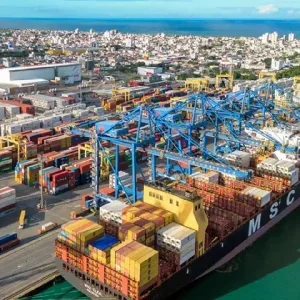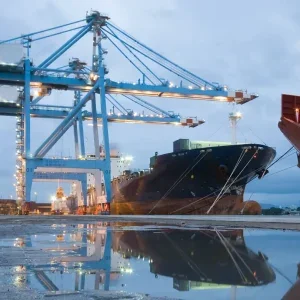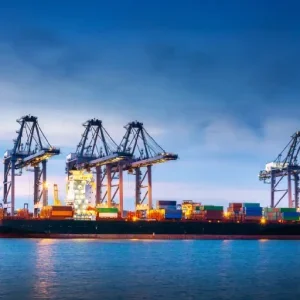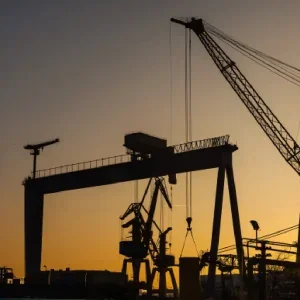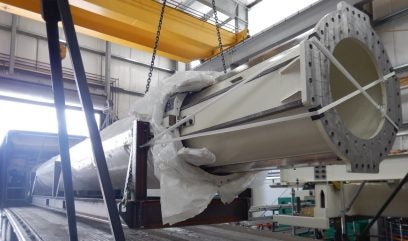
Casper, Phillips & Associates (CP&A) has designed a 1-ton capacity overhead stacker crane for painting airplanes at a large aerospace manufacturer.
CP&A which offers services, including specification, design, manufacturing review, modification, and accident investigation — accepted a scope of work to replace an existing three-rail stacker crane, including full mechanical and structural design services.
The company designed a new trolley, mast, and platform. The scope also included structural and mechanical calculations, design drawings, operations and maintenance manual, construction support, commissioning support, and record drawings. CP&A coordinated with the systems integrator and electrical engineering team. Given it was a design-bid-build, it was awarded the structural and mechanical design based on qualifications; it produced all the design documents, then the owner put out a tender for the cranes to be built to the drawing set.
CP&A’s involvement with the project started with creating a design that satisfied the performance specification. The design went through multiple reviews, both by the owner and a third-party peer. CP&A was able to re-use the bridge structure but replaced all the electrical and mechanical components. Keeping the bridge structure dictated some design decisions such as retention of a round versus square mast.
In this case, four axis of motion — bridge, trolley, rotate, and hoist — are possible. Each axis is powered by a different motor: the hoist motor moves the load up and down, while the guide rollers (wheels) allow smooth motion of the mast system. The guide rollers allow the mast to move up and down and prevent the mast from swinging. For trolley, bridge, and rotate motions, the mast system prevents the platform from swinging back and forth or twisting.
A stacker crane uses a telescoping mast to stabilize a load while it is being moved around. The biggest difference between stacker cranes and regular overhead cranes is that stackers have a telescoping mast system that does not allow the load to swing like a typical overhead crane that uses only ropes to support the load. The mast is essentially a guide that allows the load to move up and down but prevents load sway or unintended lateral movement.
Stacker cranes allow precise control of loads, which was especially important in this case, given the large hoist travel range of 57 ft. Further, the crane must allow the loaded platform to get close to the plane — within touching distance — to allow painting, but never contact it. Even a small dent would result in expensive repairs and downtime.
Stacker cranes have different rail designs. The facility’s existing two- and three-rail systems always have a load applied in the radial direction of the mast due to the eccentric platform load. Radial loads tend to bend the mast cross section out of plane — and out of round deformations cause stress concentrations, forcing the round shape to look like an ellipse. This causes the mast systems to jam a lot more towards the end of their useful life. A four-rail system eliminates radial loads and allows the loads to be transferred tangent to the tube, which doesn’t locally deform the tube out of plane.
Richard Phillips, mechanical engineer at CP&A, said: “One of the biggest design decisions we had to make was the that of the mast rail system. By using four rails, we were able to create a more favorable load path and direct the loads to transfer from the platform to the mast tube in the most favorable way possible. We optimized the load path, which lead to a minimum weight design and has the added benefit of being easier to maintain.
“Remember, a load path is how the force gets transferred from one place to another. An easy experiment is to squeeze an empty can of soda and see how easy it is to create a bulge. Compare that to twisting the can, it takes much more effort to damage the can by twisting. Chances are you’ll only be able to break it by gripping too hard and unintentionally squeezing it.
“Reducing the weight of the mast system was important; this allowed a larger platform, while maintaining the weight of the previous stackers. Maintaining the weight was very important for structural considerations related to the building.”
Notably, even with the weight of a fourth rail, the mast tube did not need to be as thick, since the load path from the guide rollers to the mast tube was tangent to the mast tube. As Phillips said, when the platform rotates, it wants to twist (torque) the mast tube, and tube sections are very strong against torsion. The two-rail tube was ½” thick and the three-rail tube was 3/8” thick. CP&A was able to get the four-rail tube thickness down to 3/16”, thus, saving weight despite having more rails than the other systems.
Another concern about the older cranes, Phillips said, was that the running surface of the bar rail was pitting. Pitting occurs when there is repeated loading and the contact stresses between the guide rollers and running surface are high enough to start peeling off the top layer of the running surface.
“The pitting phenomenon was difficult to solve,” he said. “Hardened tool steel offers great pitting resistance; however, it is very difficult to weld and machine.”
The issue was solved by doubling the number of followers and bolting on hardened rail runners. Only the running surface needs to be hardened so CP&A chose to bolt hardened rail runners onto a machined surface on a channel section. The rail runners were made out of tool steel and hardened with a gas nitride process after machining.
“Gas nitriding is a great way to harden steel and maintain dimensional control,” Phillips explained. “The use of tool steel was only possible because the steel was not being welded. For bolted rails you just undo the bolts and replace the rails. Welded rails are much harder to replace; when they have too much wear the whole mast would need to be replaced.”
The stacker cranes that were being replaced used A514 (also referred to as T-1), which requires a special weld procedure. T-1 steel is much harder than standard structural steel; for the existing cranes the rails had a hardness of about 300 Brinell (145 ksi), while, for comparison, the replaceable tool steel rails were hardened up to 475 Brinell (240 ksi), so they are much less prone to pitting.
- The crane features a series of complex features, such as collision avoidance and operating in a hazardous zone, while carrying people.


